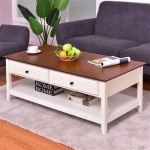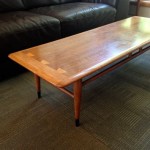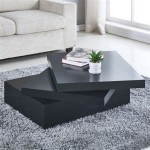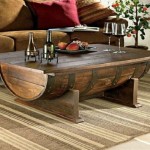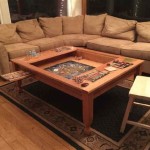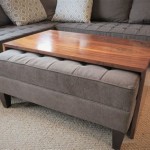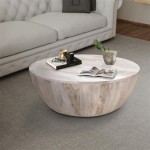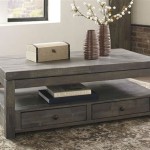Advantages of Glass and Wood Coffee Tables & End-of-Life Span Comparison
The coffee table, a fixture in living rooms and reception areas, serves as both a functional surface and a decorative element. Amongst the diverse materials used in coffee table construction, glass and wood stand out as popular choices. Each material presents distinct advantages related to aesthetics, durability, maintenance, and environmental impact, influencing its suitability for various settings and user preferences. Furthermore, the end-of-life span and disposal or repurposing options of glass and wood coffee tables differ significantly, impacting their overall sustainability profile.
Aesthetic Advantages of Glass and Wood Coffee Tables
Glass and wood offer contrasting aesthetic qualities that cater to different design sensibilities. Glass coffee tables often lend a modern, minimalist, or contemporary feel to a space. The transparency of glass creates an illusion of spaciousness, making it particularly advantageous for smaller rooms where visual clutter should be minimized. A glass tabletop allows the rug and flooring beneath to remain visible, contributing to a sense of openness and lightness. Glass can be tempered for safety, offering a sleek, smooth surface that is often paired with metal or wooden legs for structural support and visual contrast.
Furthermore, glass can be manufactured in various shapes and sizes, enabling a multitude of design possibilities. Clear glass is a classic choice, but tinted, frosted, or textured glass can also be used to achieve specific aesthetic effects. The reflective nature of glass can also enhance the ambient light in a room, making it appear brighter and more inviting.
Wood coffee tables offer a warmer, more traditional, or rustic aesthetic. The natural grain and texture of wood add character and depth to a space, creating a sense of coziness and comfort. Wood can be stained, painted, or left natural, allowing for a wide range of color and finish options to complement existing furniture and décor. Different types of wood, such as oak, maple, walnut, or pine, offer varying degrees of durability, grain patterns, and color tones. Each wood type brings its own unique aesthetic quality to the coffee table, contributing to the overall style of the room.
The versatility of wood also allows for intricate carvings, moldings, and inlays, adding decorative details that are often absent in glass coffee tables. Solid wood coffee tables are often perceived as more substantial and durable, creating a sense of stability and permanence. Wood can also be combined with other materials, such as metal, glass, or stone, to create unique and visually appealing designs. Hybrid designs that incorporate both wood and glass offer a balanced aesthetic, combining the warmth of wood with the sleekness of glass.
Durability and Maintenance of Glass and Wood Coffee Tables
The durability and maintenance requirements of glass and wood coffee tables differ considerably, impacting their long-term usability and appearance. Tempered glass, commonly used in coffee tables, is significantly stronger than regular glass and is designed to shatter into small, relatively harmless pieces if broken. However, glass is still susceptible to scratches, chips, and fingerprints, requiring regular cleaning and careful handling.
Cleaning glass coffee tables typically involves using a glass cleaner and a soft cloth to remove smudges and fingerprints. More stubborn stains may require a specialized cleaning solution. While glass is resistant to most liquids, prolonged exposure to acidic substances can etch the surface. The frames supporting glass tabletops are usually made of metal or wood, and these materials will have their own maintenance considerations.
Wood coffee tables offer varying degrees of durability depending on the type of wood used and the quality of the finish. Hardwoods such as oak, maple, and walnut are more resistant to scratches, dents, and wear than softwoods like pine. A protective finish, such as varnish, lacquer, or polyurethane, can further enhance the durability of a wood coffee table by providing a barrier against moisture, stains, and scratches.
Maintenance of wood coffee tables typically involves dusting regularly with a soft cloth and occasionally cleaning with a wood cleaner or polish. Spills should be wiped up promptly to prevent staining. Depending on the type of finish, wood coffee tables may require periodic refinishing to restore their appearance and protect the wood from damage. Scratches and dents can often be repaired with wood filler or touch-up paint. While wood can be more resistant to minor impacts than glass, it is susceptible to water damage and warping if not properly sealed and maintained.
End-of-Life Span Comparison and Environmental Considerations
The end-of-life span and disposal of glass and wood coffee tables present different environmental considerations. Glass, being an inorganic material, is highly recyclable and can be melted down and reused to create new glass products. However, not all recycling facilities accept all types of glass, particularly tempered glass, which requires a higher melting temperature. If a glass coffee table cannot be recycled, it typically ends up in a landfill, where it can remain for an extremely long time without decomposing.
The metal frames often used with glass coffee tables are also recyclable, providing an opportunity to recover valuable resources. Proper separation of the glass and metal components is essential for effective recycling. The energy required to recycle glass is lower than the energy required to produce new glass from raw materials, making recycling a more environmentally friendly option.
Wood coffee tables, on the other hand, offer more diverse end-of-life options. Solid wood coffee tables can be repurposed, refinished, or upcycled into other furniture pieces or decorative items. Wood is also a biodegradable material, although the decomposition process can take a considerable amount of time in a landfill. Burning wood coffee tables is an option, but it releases carbon dioxide and other pollutants into the atmosphere, contributing to air pollution. The environmental impact of burning wood depends on the efficiency of the combustion process and the presence of any coatings or finishes that may release harmful chemicals when burned.
The sustainability of a wood coffee table also depends on the source of the wood. Wood from sustainably managed forests is a more environmentally responsible choice than wood from illegally logged or deforested areas. Certifications such as the Forest Stewardship Council (FSC) provide assurance that the wood has been harvested in a sustainable manner. Using reclaimed or recycled wood is another way to reduce the environmental impact of wood furniture. Reclaimed wood often has a unique character and patina, adding a distinctive touch to the coffee table.
Ultimately, the environmental impact of a coffee table, whether made of glass or wood, depends on a combination of factors, including the materials used, the manufacturing process, the transportation distance, the product's lifespan, and its end-of-life disposal method. Choosing durable, well-made coffee tables that are designed to last can extend their lifespan and reduce the need for frequent replacements. Proper care and maintenance can further prolong the lifespan of a coffee table, minimizing its environmental footprint. When a coffee table reaches the end of its useful life, exploring options for recycling, repurposing, or donating it can help to divert waste from landfills and conserve resources.
In summary, both glass and wood coffee tables offer distinct advantages in terms of aesthetics, durability, and environmental impact. The choice between the two depends on individual preferences, lifestyle, and environmental considerations. Understanding the properties and characteristics of each material can help consumers make informed decisions that align with their values and needs.

Wood Pedestal Coffee Table Low Minimalist Profile Rectangular

Dutton Rustic Wood Square Coffee Table From Dutchcrafters Amish

Oak Wood Mission Square Coffee Table From Dutchcrafters Amish

19 Coffee Tables With Storage To In 2024 All Our Picks
Oak End Table With Mexican Tiles Wooden Console Stand By Halohope Design Wescover Tables

Coffee Table Tropical Hardwood Live Edge Wood Walnut Modern With U Shaped Legs

Reviews For Nathan James Stella 40 In 2 Piece Rustic Oak Rectangle Mdf Wood Top Coffee Table With Nesting Tables Pg 1 The Home Depot

19 Coffee Tables With Storage To In 2024 All Our Picks

Why Metal Furniture And Interior Is Better Than Wooden

Litton Lane 24 In Brown Handmade Distressed Large Round Wood End Accent Table With Black Metal Hairpin Legs 042736 The Home Depot
Related Posts

